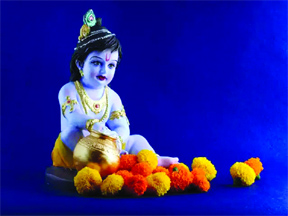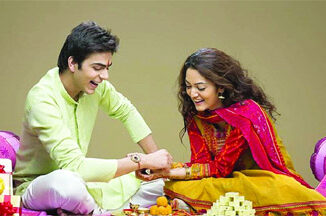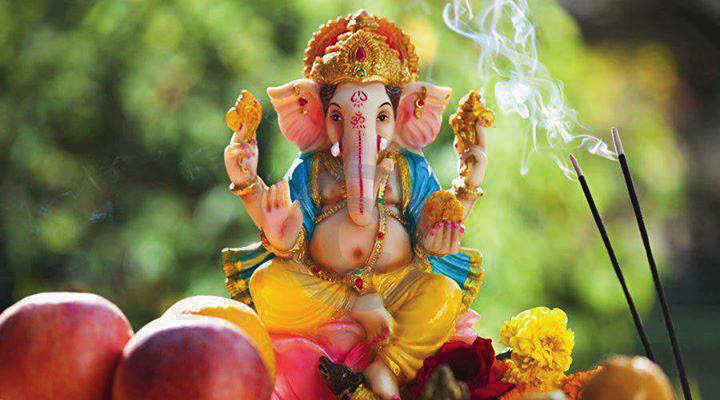
Krishna Janmashtami also known as Krishnashtami, Srikrishna Jayanti or sometimes merely as Janmashtami, is an annual celebration of the birth of the Hindu deity Krishna, the eighth avatar of Lord Vishnu. Krishna belonged to the Vrishni clan of Yadavas from Mathura (Uttar Pradesh) and was the eighth son born to the princess Devaki and her husband Vasudeva. Lord Krishna reciprocates in unique, personal ways with every devotee who offers Him love. He is the most adorable, mischievous son, the most romantic lover, the most compassionate friend as described in ancient scriptures. Krishna Janmashtami falls on the eighth day of the dark fortnight in the month of “Bhadrapada” in India. This year, Janmashtami will be celebrated on August 26. According to Hindu mythology, Krishna is the eighth avatar of Lord Vishnu and also the eighth child of Devaki and Vasudev. Devotees mark this auspicious occasion by observing a fast and praying to Lord Krishna. People adorn their homes with flowers, diyas and lights. Temples are also beautifully decorated and lit.
According to Vedic chronology, this year will mark the 5,251th birthday of Krishna. The festival is especially observed in Mathura, Vrindavan and Dwarka, where the God was believed to be born and spent his growing years.
History and significance
According to Hindu mythology, Krishna is the eighth avatar of Lord Vishnu and also the eighth child of Devaki and Vasudev. He was born on Janmashtami to destroy and defeat the demon king of Mathura, Kansa, who was also Devaki’s brother. The demon king had captured and kept Devaki and Vasudev in prison because of a prophecy that claimed that the couple’s eighth son would cause Kansa’s downfall. Due to this, he killed off six of their children. It is believed that at the time of their seventh child Balram’s birth, the foetus magically transferred from Devaki’s womb to Princess Rohini’s. When Krishna was born, the entire palace fell into a deep slumber. The prison gates magically opened and Vasudev carried Krishna to Nand Baba and Yashoda in a basket on his head. He crossed the river Yamuna to reach Vrindavan and handed Krishna to them. Vasudev returned to the palace with a baby girl. When Kansa tried to kill the baby girl, she transformed into Goddess Durga and warned him of his death. Krishna grew up in Vrindavan and subsequently killed his uncle.
Celebrations
Janmashtami is a huge festival in India as it marks the victory of good over evil. On this day, devotees fast and read the Bhagavad Gita as well. They pray to Lord Krishna and distribute sweets. At midnight, priests open the drapes and reveal Krishna’s beautifully decorated deity adorned with new clothes.
People also mark the day by celebrating the “Dahi Handi” festival. It is quite popular in the states such as Gujarat and Maharashtra. Young boys come together to make a human pyramid and aim to break an earthen pot filled with dahi or curd. The pot is hung very high from the ground and the festival highlights the mischievous and playful personality of Lord Krishna. It is believed that he loved “makkhan” or butter very much and used to steal it, thus earning him the name “Makkhan Chor”.
Krishna Janmashtami puja procedure
Before the day of Krishna Janmashtami, the household is cleaned and decorated. On the day of Krishnashtami, the devotees wake up early in the morning and take a holy bath. Then the puja altar is set up. Preferably, the puja altar can be set up in the puja room itself. If you are planning for an elaborate puja, you can organize the puja altar in the main hall also.
Sri Krishna’s idol is the central attraction of the Krishnashtami puja. Some people use the regular idol or picture they have in their puja room. Some people buy a new image of Krishna every year for the puja. Depending on which material the Krishna idol is made of, you can plan for a holy bath for the idol; or can simply decorate the idol with flowers, clothes, and ornaments. In many Hindu households, people draw the images of little footsteps leading from the main door to the puja room. This practice symbolically represents Sri Krishna’s little feet bringing him into the household to bless the puja and the residents of the house. Krishna’s visit to every home during the puja is said to fill the home with prosperity and happiness. Light the lamp and offer incense to the Lord. Offer Chandan and kumkum. Offer special homemade prasad. Curd/yoghurt, ghee, butter, and other milk products and milk-based sweets are especially suitable to offer to Lord Krishna. Do not forget berries and other fruits. Sing the songs of Krishna and chant some shlokas and mantras related to Krishna. Wave camphor and conclude the puja. Share the prasad with the gathering and family as a mark of Krishna’s blessings.





Be the first to comment